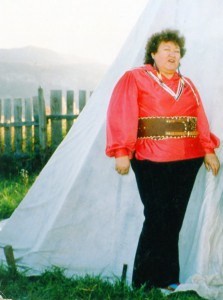
Minerva Allen lives in Northern Montana on the Fort Belknap Reservation in Lodge Pole with her family in the foothills of the Little Rockies known as the Island Mountains to the Nakoda. She owns a ranch with cattle and many horses that roam the ridges in Big Warm. She coordinates the Lodge Pole Senior Programs and teaches the Nakoda Language twice a week nightly. She enjoys rodeos and life.
Her book, Nakoda Sky People, is a compilation of poems from several of Allen’s smaller collections, and also contains a lexicon of Nakoda words and phrases as well as pages of Native recipes and herbal medicines.
In an introductory essay to her collection of poems, Minerva Allen states directly, “We keep our history and culture alive by telling of our ancestors and legends to young people.” She tells of learning the Assiniboine way of life from her grandparents, and now she feels a duty to pass along what she knows. “When I go to sleep at night,” Allen writes, “my prayer to the creator is to let me stay a little longer here on earth. I have unfinished business. I want to write and leave some good words for my people.” What does she want her reader (outside the tribe) to know/understand about her culture? Minerva Allen replies, “First of all it’s letting people know how we are different.” These thoughts are expressed beautifully in her short lyric poem, “Ashes”:
The ashes of our ancestors are sacred
and their resting places are hallowed ground.
Our religion is the traditions of our ancestors—
dreams of our old men given to them
in solemn hours of the night; and the visions
of our medicine men. It is written
in the hearts of our people.
One of the most unusual and inventive poems in this collection is the poem “Seeing a Pow-Wow through the Eyes of a Friend” in which the poet enjoys watching her friend gain appreciation for the dance. This poem also exemplifies Allen’s strategy to bridge the cultural gap by “letting other people know how we are different.” She compares the pow-wow to a three ring circus, a metaphor by which she communicates her culture to her non-Indian friend:
A ring master controlling the kids and the crowd.
Each event following into place
as the evening flows; night passes through.
The beautiful colors flashing.
The quick steps of young girls.
Each doing what has been done for centuries—
young men, old men, the proud
look of their heritage . . . .
Each knowing his place and time
for honor dances, memorials and giveaways . . . .
The pride which travels through one’s being
each in his own way. ~ “Seeing a Pow-Wow through the Eyes of a Friend”by Minerva Allen
The poems “Snake Man” and “Gumbo Lily” recount traditional stories. “Snake Man” is a legend in which a man eats a snake and becomes a snake himself, promising the rest of the tribe, “Every time you come,/ leave me something to eat and I will/ lay across the big water for you to cross/ on my back.” The poem “Gumbo Lily” is the story of the origin of a plant by that name common in central Montana. These are examples of poems which pass along lasting traditions, educating younger generations. “Indian writers” Allen says, “might come from different eras, different places, different tribes, but we all have one thing in common—we are storytellers from a long way back and we will be heard for generations to come.” Similarly the poem “Ghost Dance” alludes to the aurora borealis. This poem may have sprung from a traditional tale, or it may be the invention of the poet. Either way, this poem is Minerva Allen’s storytelling magic at its best:
In the dark of the night
the stars up above
are our guide.
The moon is sleeping.
The ghost-lights dance
long streaks
from the earth to the sky
in the North.
Don’t look my children.
It’s the ghost dance.
Up North
the spirits are angry
and doing a war dance. ~ “Ghost Dance” by Minerva Allen